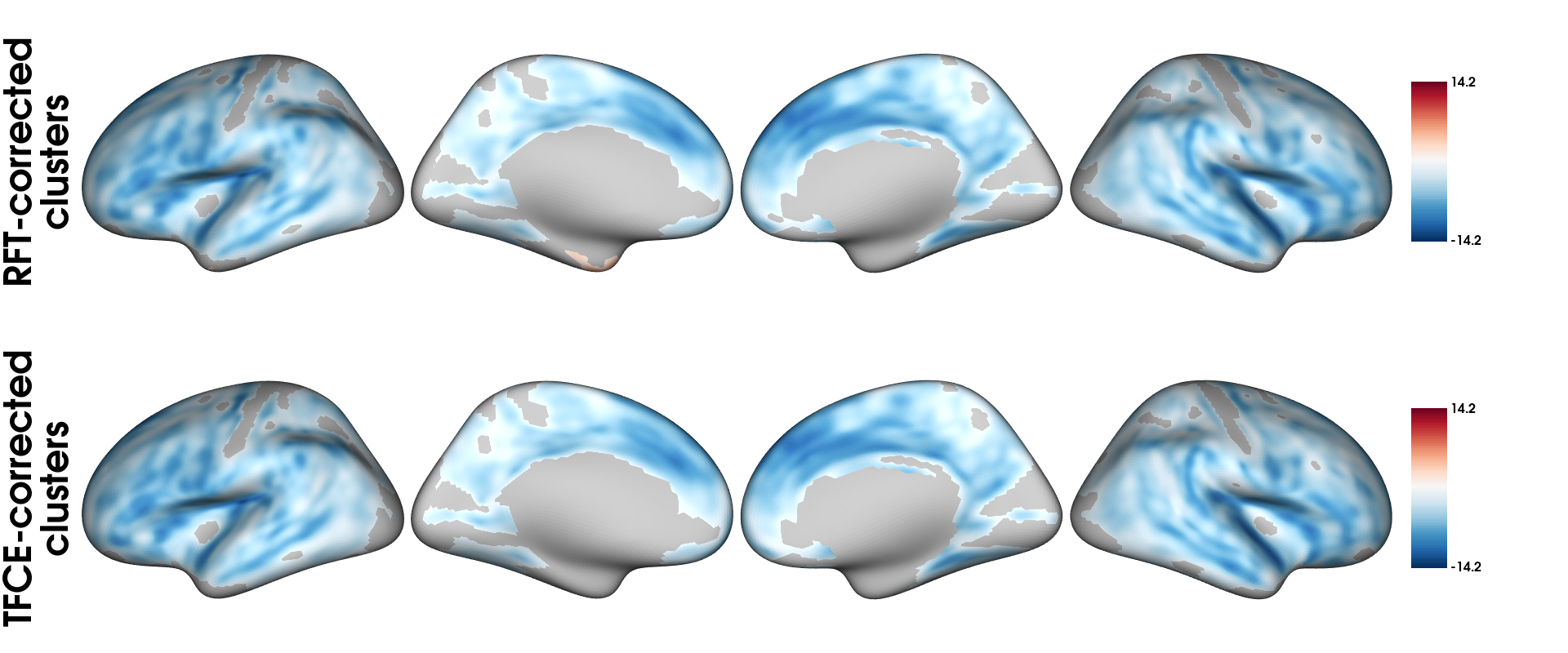
Example analyses with VertexWiseR - Example 1
Charly Billaud, Junhong Yu
2025-07-16
VertexWiseR_Example_1.RmdInstalling VertexWiseR and checking for requirements
The following code installs the package and makes sure all requirements, prompting the user to install dependencies, in order to allow analyses to work.
install.packages("VertexWiseR") VWRfirstrun() checks all system requiremements for specific functions, and gives the opportunity to download and install each of them.
Example analysis 1: linear model of age and cortical thickness, and meta-analytic decoding
The analysis will use surface data already extracted in R from a preprocessed subjects directory, which we make available so you do not need to preprocess a sample yourself. To obtain it, we had extracted cortical thickness (CT) data from a FreeSurfer preprocessing directory of the SPRENG dataset (Spreng et al. 2022).
The demo data (218 MB) required to run the package demos can be downloaded from the package’s github repository with the following function:
#This will save the demo_data directory in a temporary directory (tempdir(), but you can change it to your own path)
demodata=VertexWiseR:::dl_demo(path=tempdir(), quiet=TRUE)Here is the command line which was originally used to extract the surface:
#SURFvextract(sdirpath = SUBJECTS_DIR, filename = "SPRENG_CTv", template='fsaverage5', measure = 'thickness', subj_ID = T)To load the demo thickness matrix:
To smooth the surface data:
SPRENG_CTv_smoothed = smooth_surf(SPRENG_CTv, 10)To load the demo behavioural data (for participants in site 1, SPRENG_behdata_site1.csv):
To run the vertex-wise model analysis with random field theory-based cluster correction, testing for the effect of age, controlling for sex, on CT:
model1_RFT=RFT_vertex_analysis(model = dat_beh[,c("sex","age")],
contrast = dat_beh[,"age"], surf_data = SPRENG_CTv_smoothed, p = 0.05)
model1_RFT$cluster_level_results## $`Positive contrast`
## clusid nverts P X Y Z tstat region
## 1 1 142 0.015 -22.8 11.5 -42 6.45 lh-temporalpole
##
## $`Negative contrast`
## clusid nverts P X Y Z tstat region
## 1 1 8039 <0.001 47 4.0 -16.6 -12.64 rh-superiortemporal
## 2 2 7660 <0.001 -34 -25.7 16.2 -14.23 lh-insulaTo run the vertex-wise model analysis with threshold-free cluster enhancement-based cluster correction, testing for the effect of age, controlling for sex, on CT; with 1000 permutations:
model1_TFCE=TFCE_vertex_analysis(model= dat_beh[,c("sex","age")],
contrast = dat_beh[,"age"],
surf_data=SPRENG_CTv_smoothed,
nperm=1000,
nthread=4)
TFCEoutput = TFCE_threshold(model1_TFCE, p=0.05)
TFCEoutput$cluster_level_results## $`Positive contrast`
## [1] "No significant clusters"
##
## $`Negative contrasts`
## clusid nverts P X Y Z tstat region
## 1 1 8098 <0.001 47 4.0 -16.6 12.64 rh-superiortemporal
## 2 2 7617 <0.001 -34 -25.7 16.2 14.23 lh-insulaTo plot the results of both models on an inflated fsaverage5 surface:
tmaps = rbind(model1_RFT$thresholded_tstat_map, TFCEoutput$thresholded_tstat_map)
plot_surf(surf_data = tmaps,
filename ='SPRENG_tstatmaps.png',
size=c(1400,582),
surface = 'inflated',
title=c("RFT-corrected\nclusters", "TFCE-corrected\nclusters"),
cmap='RdBu_r',
show.plot.window=FALSE)
To run meta-analytic decoding of the significant negative clusters (the neurosynth dataset needs to be installed as VWRfirstrun() allows):
surf_decoding=decode_surf_data(TFCEoutput$thresholded_tstat_map, contrast="negative")
head(surf_decoding)## keyword r
## 538 retrieval 0.065
## 202 episodic 0.059
## 348 memory 0.053
## 198 engagement 0.048
## 332 linguistic 0.048
## 439 older 0.047